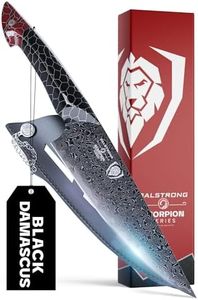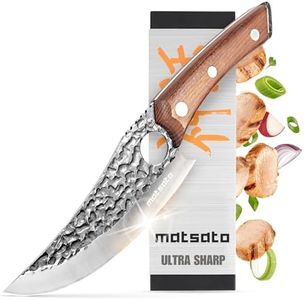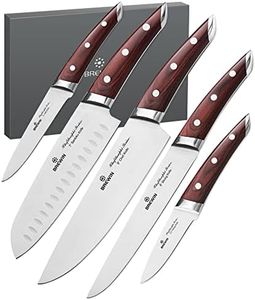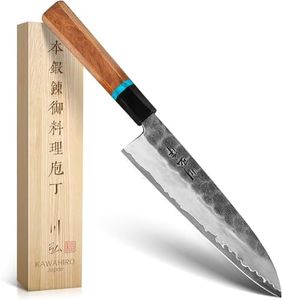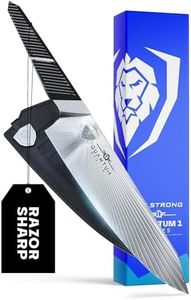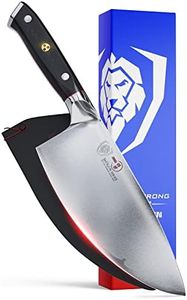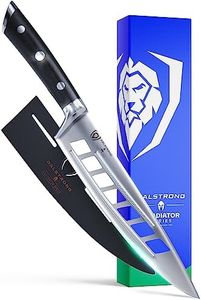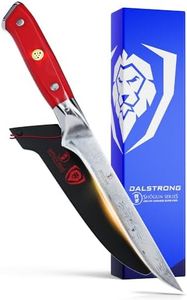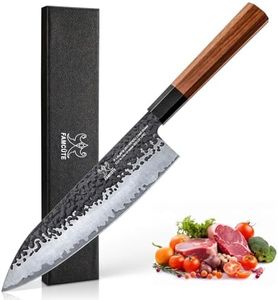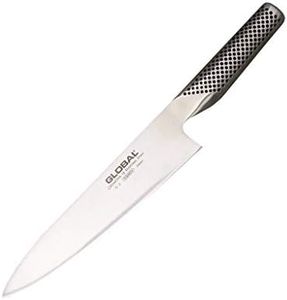10 Best Japanese Chef Knives 2025 in the United States
Our technology thoroughly searches through the online shopping world, reviewing hundreds of sites. We then process and analyze this information, updating in real-time to bring you the latest top-rated products. This way, you always get the best and most current options available.

Our Top Picks
Winner
Matsato Chef Knife - Perfect Kitchen Knive. Japanese Knife for Cooking, Chopping. Japanese Style Knive for Home, Camping, BBQ. For Balance & Control
Most important from
1973 reviews
The Matsato Chef Knife is a versatile tool designed for both home cooks and professional chefs. Made from high-quality stainless steel, its blade is durable and sharp, promising not to dull or chip easily. The knife features a 6.2-inch blade that is suitable for various kitchen tasks, from chopping vegetables to slicing meats. Its solid oak handle ensures a firm grip and balanced control, making cutting safer and more comfortable.
However, while the handle's material adds to the knife's quality, it may require extra care to maintain its condition over time since it is not dishwasher-safe. Weighing 6.2 ounces, the knife is lightweight, which can be a plus for prolonged use but might feel less substantial to those who prefer heavier knives. The Matsato Chef Knife's traditional Japanese craftsmanship combined with modern techniques makes it a reliable kitchen tool, also applicable for outdoor activities like camping and BBQs.
With a blend of durability, balance, and versatility, the Matsato Chef Knife is a strong contender in its category, though it requires careful hand washing to maintain its performance and appearance.
Most important from
1973 reviews
Brewin CHEFILOSOPHI Japanese Chef Knife Set 5 PCS with Elegant Red Pakkawood Handle Ergonomic Design,Professional Ultra Sharp Kitchen Knives for Cooking High Carbon Stainless Steel
Most important from
1867 reviews
The Brewin CHEFILOSOPHI Japanese Chef Knife Set is a well-crafted collection ideal for both professional chefs and home cooking enthusiasts. The knives are made from high-carbon German stainless steel, known for its durability and sharpness, with a Rockwell hardness score of 56+. This ensures the blades are tough and resistant to rust, making them long-lasting kitchen tools. Each knife features an elegant red pakkawood handle that is not only visually appealing but also designed for ergonomic comfort and excellent balance.
This set includes five knives: two 8-inch knives, a santoku knife, a 5-inch utility knife, and a smaller paring knife, all packaged in luxurious gift boxing. The plain blade edge ensures precise cutting and easy maintenance. With an overall weight of 2.6 pounds, these knives are lightweight yet feel stable in hand, making them suitable for various kitchen tasks.
While the knives are dishwasher safe, hand washing is generally recommended for maintaining the knife’s quality over time. Additionally, the metal and stainless steel handle material may not be as slip-resistant as some other materials when wet. This knife set combines durability, sharpness, and ergonomic design, making it a great choice for those seeking high-quality kitchen knives.
Most important from
1867 reviews
KAWAHIRO Japanese Chef Knife, 210mm Black Forged VG10 Kitchen Knife, Handcrafted Professional Chefs Knife with Ergonomic Handle, Perfect Birthday Gifts for Men Women, Luxury Gift Wood Box
Most important from
164 reviews
The KAWAHIRO Japanese Chef Knife is a well-crafted kitchen tool that appeals to both professional chefs and home cooking enthusiasts. With a blade length of 210mm (about 8.25 inches) made from VG-10 stainless steel, it promises impressive sharpness and durability. Users will appreciate the precision it offers in slicing, making it ideal for any kitchen task, from chopping vegetables to filleting fish.
One of the standout features is the ergonomic handle made from a combination of ruby wood, turquoise, and ebony, designed for comfort and control. This means you can use it for extended periods without experiencing discomfort, which is great for those who love to cook. The knife's balanced weight also aids in maneuverability, allowing for smooth and precise cuts.
However, there are a few considerations to keep in mind. While the knife's beautiful design and craftsmanship make it a stunning addition to any kitchen, it also means that care is needed to maintain it. It's not dishwasher safe, which can be a hassle for some users who prefer easy cleaning. Additionally, the price point might be higher than entry-level kitchen knives, which could be a barrier for those just starting out.
